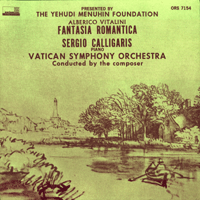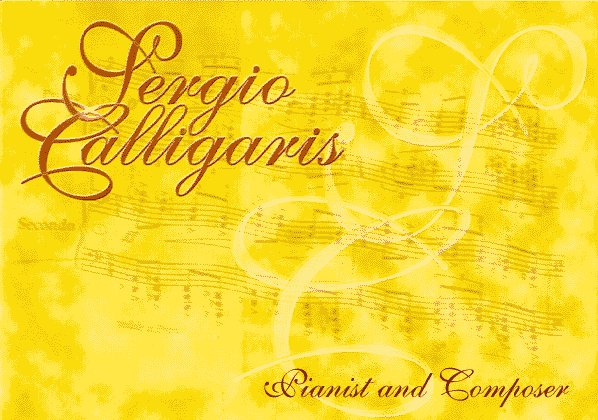 FANTASIA ROMANTICA
FANTASIA ROMANTICA
Sergio Calligaris at piano
[LP: Orion Records, stereo ORS 7154]
SIDE 1
Alberico Vitalini:
Fantasia romantica (1949), for piano and orchestra (12'49")
Scherzo (1955) (4'19")
Enrique Granados:
Spanish Dance N.5 "Andalucia" (4'31")
Manuel De Falla:
Ritual Fire Dance (3'54")
SIDE 2
Robert Schumann:
Aufschwung, Op.12 N.2 (4'03")
Claude Debussy:
Feu d'artifice (4'41")
Sergei Rachmaninov:
Prelude in C sharp minor, Op.3 N.2 (4'50")
Prelude in G minor "Alla marcia", Op.23 N.5 (4'54")
Franz Liszt:
Hungarian Rhapsody N.6 in D major (8'07")
ALBERICO VITALINI (b.1921), the noted Italian composer, has since 1950 been
music director of the Vatican State Radio. He enjoys an outstanding reputation in Europe,
and his compositions are programmed regularly in all leading music capitals. He has a
large number of recordings, both as a composer and as conductor on the RCA Italian label.
In 1958 he was awarded the coveted ONDAS International Prize in Barcelona, and in 1966 one
of his film scores received a first award at the Venice Film Festival. The Fantasia for
Piano and Orchestra (1949) is a youthful work, with melodies of intense romanticism,
episodes of great brilliance and dazzling pianistic fireworks, others of spontaneous and
refreshing charm, alternating with impressive orchestral tutti. The solo piano part is
superbly written, using the most honest and direct pianistic effects with great
musicianship and skill. An impressive cadenza precedes the brilliant and exciting coda.
The overall impression is one of sincere and rich musical inspiration combined with
overwhelming optimism and joy.
The Scherzo (1955) is an exquisite work, abounding with the greatest originality
of ideas. The first section is in an attractive dance character, with the main theme
introduced in fugato form, followed by bouncing rhythms that the composer uses again to
advantage in the coda. The trio has a tender and nostalgic mood, with a ballad-like theme
of disarming simplicity.
The Ritual Fire Dance by Manuel De Falla (1876-1946), with its incisive rhythms,
diabolic trills and frenzied mood, contrasts sharply with the sophisticated melodiousness
of the Spanish Dance (Andaluza) No.5 by Enrique Granados (1867-1916),
wherein the first and last sections boast a fascinatingly beautiful theme, backed by an
elegantly enunciated rhythmic pattern, while the central section is poetic and intimate in
mood.
ROBERT SCHUMANN (1810-1856) was one of the most fascinating musical
personalities of the Romantic era. In Soaring (Aufschwung), Op.12 No.2 we hear him
in a mood rich with passionate lyricism, strength and expressive intensity.
CLAUDE DEBUSSY (1862-1918), the great French impressionist and a marvellous
painter of sounds, brings to his prelude Fireworks (Feu d'Artifice) a fantastic
image of radiant sonorities, movement and fascinating shapes.
SERGEI RACHMANINOFF (1873-1943) was a late Romantic, and his music is
tremendously expressive and rich in generious melodies, bold sonorities and subtle
harmonization. His Prelude Op.3 No.2 is sombre and solemn in mood, with an agitated
episode in the middle, culminating in an apotheosis of the first theme, finally slowly
fading away. The Prelude Op.23 No.5 is an exciting and march-like composition with
a touching, melodious trio imbued with Romantic spirit.
The Hungarian Rhapsody No.6 by Franz Liszt (1811-1886) captures all the
soul and vitality of the gypsies, with their contagious enthusiasm, heard in the first
episode. This is followed by a melodic interlude, charged with sentiment, freedom of
expression and even a touch of melancholy. The coda, with its famous theme, elegant and
capricious at first, gradually grows faster and more sparkling, culminating in a frantic
dance.
1971 ORION RECORDS

